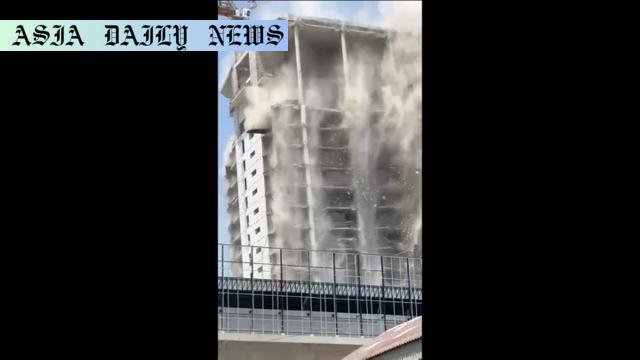Thailand earthquake – Thai officials to probe if design or structural flaws caused the total collapse of a high-rise building during a recent quake.
Thai government to investigate causes of high-rise collapse following Myanmar earthquake.
Collapsing building was a 33-story project designated for the government’s audit office.
Construction involved a joint venture between Thai and Chinese firms, raising scrutiny on international standards.
Prime Minister orders expert committee to analyze design or structural issues and deliver findings within a week.

Collapse of a High-Rise in Thailand Sparks Investigation
In the wake of last week’s earthquake centered in neighboring Myanmar, the collapse of a 33-story high-rise building in Thailand has raised urgent questions about construction integrity and disaster resilience. Thai authorities are preparing to investigate the reasons behind the complete failure of the structure, formerly designated to serve as the government’s audit office. This incident, though not involving other structural collapses, has ignited concerns about the lasting safety of high-rise buildings across Bangkok and beyond.
International Collaboration Under Scrutiny
At the heart of this tragedy lies a joint venture between a Thai construction company and the local subsidiary of a Chinese state-owned enterprise. The latter had previously highlighted this project as a milestone, marking its first contribution to high-rise construction outside of China. However, scrutiny intensified following the collapse, leading many observers to question whether lapses, either in design or material quality, contributed to the disaster. Moreover, the company appears to have removed online announcements celebrating its involvement in this venture, raising suspicions about their oversight practices and project accountability.
Government’s Proactive Approach
Thai Prime Minister Paetongtarn Shinawatra has demonstrated a decisive response to the crisis. During her site visit, she not only expressed support for the affected but also announced the formation of a specialized committee of experts tasked with identifying the root causes of the collapse. This group is set to explore potential design flaws, structural inadequacies, or other contributing factors, with findings expected to emerge within the week. This swift action underlines the government’s commitment to public safety and infrastructure standards, especially in a city such as Bangkok, known for its dense urban landscape and constant construction activity.
Lessons in Urban Safety
This incident serves as a stark reminder of the vital role that architectural and engineering standards play in urban development. High-rise buildings encapsulate ambition and innovation, but they also demand rigorous safety measures, particularly when constructed in earthquake-prone regions. As Bangkok continues to grow, the integrity of its infrastructure will increasingly define its resilience against natural disasters. This tragic event underscores the necessity of stringent construction monitoring and highlights potential gaps that must be addressed to avert similar failures in the future.
A Global Call for Construction Accountability
The story reverberates beyond Thailand, challenging global construction industries to rethink how accountability and safety checks are administered in cross-national collaborations. This calls for better transparency, robust standards, and collaborations steeped in ethical responsibility. The Thai government’s upcoming report will not only shed light on the immediate causes but could also act as a wake-up call for other developing nations undergoing rapid urbanization.



Commentary
Investigating the Root of the Collapse
The collapse of the 33-story high-rise in Thailand following the Myanmar earthquake is a tragedy that brings to light significant issues in construction and urban planning. One wonders how a building under construction could completely fail, while others in the same city faced no such calamity. This suggests possible lapses in design assessment, material quality, or adherence to safety standards, underlining a systemic challenge that Thai authorities must address urgently.
The Role of Cross-Border Collaborations
This incident also raises questions about the dynamics of international collaborations in construction. While joint ventures between Thai and Chinese firms reflect globalization and shared expertise, they also demand a higher degree of accountability. Cross-national projects should carry rigorous checks at every level—designing, material sourcing, and execution. The alleged removal of the Chinese firm’s online announcement about its involvement speaks volumes about the potential gaps in the oversight and auditing of such projects.
A Wake-Up Call for Urban Planning
Not only for Thailand but for urbanizing nations worldwide, this should serve as an eye-opener about the importance of disaster resilience in infrastructure. Bangkok, a thriving city with a bustling construction scene, must prioritize safety regulations and strict building codes to ensure long-term sustainability. The lessons learned from this unfortunate event must prompt authorities to enforce stricter policies, re-evaluate current construction projects, and demand better designs aligned with seismic safety standards.
Ensuring Safety in Future Projects
As investigations unfold, it is hoped that this collapse will instigate not only local but also international dialogue about better practices in the construction industry. Structural integrity and accountability in construction should remain paramount, especially in earthquake-prone regions. The innovation required is not merely architectural but also regulatory, ensuring that regardless of scale or complexity, the focus remains on the well-being and safety of inhabitants rather than mere aesthetics or cost-cutting measures at the expense of lives.